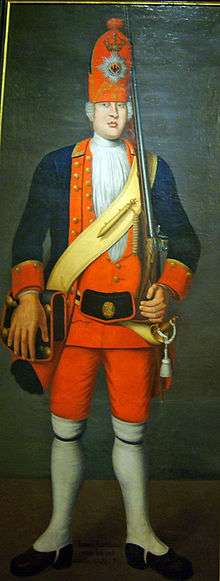Potsdam Giants
The Potsdam Giants was the Prussian infantry regiment No 6, composed of taller-than-average soldiers. The regiment was founded in 1675 and dissolved in 1806 after the Prussian defeat to Napoleon. Throughout the reign of the Prussian king Friedrich Wilhelm I of Prussia (1688–1740) the unit was known as the "Potsdamer Riesengarde" ("giant guard of Potsdam") in German, but the Prussian population quickly nicknamed them the Lange Kerls ("tall guys").
Regiment's history

The Regiment was founded with a strength of two battalions in 1675 as “Regiment Kurprinz” under the command of Prince Frederick of Brandenburg, the later King Frederick I of Prussia. In 1688 the later King Frederick William I of Prussia became the nominal Commander of the Regiment. After Frederick William I ascended to the throne in 1713, he proceeded strengthen his military, including hiring 40,000 mercenaries. He had already begun to recruit taller soldiers and needed several hundred more recruits each year.
As the number of tall soldiers increased, the regiment earned its nickname 'Potsdam Giants'. The original required height was 6 Prussian feet (about 6'2" or 1.88 meters),[1] well above average then and now. The king was about 1.6 meters himself.[2] He tried to obtain them by any means, including recruiting them from the armies of other countries. The Emperor of Austria, Russian Tsar Peter the Great and even the Sultan of the Ottoman Empire sent him tall soldiers in order to encourage friendly relations. Several soldiers were given by Tsar Peter I as a gift in return for the famous Amber Room.[3] Pay was high but not all giants were content, especially if they were forcibly recruited, and some attempted desertion or suicide.
Although Prussia briefly intervened in the Great Northern War, the Potsdam Giants never saw battle during his reign. Some sources state that there was a military reason to create a regiment of "Long Guys" because loading a muzzleloader is easier to handle for a taller soldier.[4] Another source states that many of the men were unfit for combat due to their gigantism.[5]
The king trained and drilled his own regiment every day. He liked to paint their portraits from memory. He tried to show them to foreign visitors and dignitaries to impress them. At times he would try to cheer himself up by ordering them to march before him, even if he was in his sickbed. This procession, which included the entire regiment, was led by their mascot, a bear. He once confided to the French ambassador that "The most beautiful girl or woman in the world would be a matter of indifference to me, but tall soldiers—they are my weakness". Their uniform was not in any way idiosyncratic for the time, consisting of a red mitre, a Prussian blue jacket with gold lining, scarlet breeches and white gaiters.
One of the tallest soldiers, the Irishman James Kirkland, was reportedly 2.17 meters (just under 7 ft 2 in)[6] in height. Kirkland's fellow-Irishman, the poet Tomás Ó Caiside, also served in the regiment. Another member of the regiment was Daniel Cajanus.
When the king died in 1740 the regiment had a strength of 3,200 men. However, his successor Frederick the Great did not share his father's sentiments about the regiment, which seemed to him an unnecessary expense. The regiment was largely disbanded and most of its soldiers were integrated into other units. The regiment itself was downgraded to a battalion (Garde – Grenadier No 6) and employed during the War of the Austrian Succession at Hohenfriedberg in 1745 and at Rossbach, Leuthen, Hochkirch, Liegnitz and Torgau throughout the Seven Years' War. The battalion surrendered near Erfurt and Prenzlau after the Prussian defeat at the Battle of Jena-Auerstedt in 1806 and was disbanded.
Tradition
Since 1990 a private association at Potsdam tries to draw on the tradition of the "Lange Kerls" and preserve the memory of that unit.
References
- ↑ meyers.de
- ↑ militaergeschichte.de
- ↑ Rolf Fuhrmann: Die Langen Kerls - Die preussische Riesengarde 1675/1713-1806, Zeughaus Verlag, Berlin 2007
- ↑ Jürgen Kloosterhuis: Legendäre „lange Kerls“. Quellen zur Regimentskultur der Königsgrenadiere Friedrich Wilhelms I., 1713–1740, Berlin 2003, ISBN 3-923579-03-9
- ↑ Kurt Zeisler: Die Langen Kerls. Das Leib- und Garderegiment Friedrich Wilhelms I., Frankfurt/Main 1993
- ↑ Potsdam at Marco Polo
J.N.W. Bos. 2000. Biography of Frederick William I the Soldier King of Prussia (1657-1713) Accessed 2007-10-03.
External links
- 'Lange Kerls' association (German)